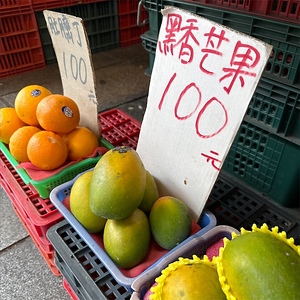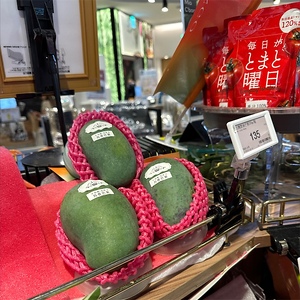


Heixiang Mangoes
Estimated Inventory, lb : 0
Description/Taste
Heixiang mangoes vary in size, depending on growing conditions and age at harvest, and average 12 to 13 centimeters in length and 7 to 8 centimeters in diameter. The fruits showcase a short, oval to oblong shape with a small, slightly curved tip and blunt, rounded ends. The skin is thick, smooth, taut, and firm, remaining green even when ripe. The surface may also be covered in some green-brown markings acquired during cultivation. These markings are only superficial and will not affect the quality of the flesh. Underneath the skin, the flesh appears in shades of golden yellow to bright orange and has a soft, aqueous, tender, and succulent consistency. Heixiang mangoes contain little fiber, and their flesh often becomes jelly-like when ripened. The flesh also encases a small, thin seed that should be discarded during consumption. Heixiang mangoes release a permeating floral, fruity, and musky fragrance that is lingering and often scents the room where it is stored. The variety’s ripeness cannot be determined by its skin color, as it remains green when mature. The fruits should instead be gently squeezed around the stem and have a soft give when ripe. They will also have a robust fragrance when mature. Heixiang mangoes are known for their high sugar content, around 15 to 16 degrees Brix, contributing to their sweet, tangy, floral, fruity, and musky flavor. Some consumers note that the mango has a scent and taste similar to longan. This flavoring is strongest in the flesh beneath the skin. The flesh closest to the central seed has more of a turpentine, jackfruit-like taste with subtle musky nuances reminiscent of durian.
Seasons/Availability
Heixiang mangoes are available for a short season between mid to late July in Taiwan, sometimes extending into August.
Current Facts
Heixiang mangoes, botanically classified as Mangifera indica, are a rare Taiwanese variety belonging to the Anacardiaceae family. The late-season variety is cultivated in Southern Taiwan and appears about one month after the commercially dominant Aiwen mango. Heixiang mangoes are distinct from other mango varieties as their skin remains dark green, even when ripe, and the flesh has a fruity, floral, and subtly musky taste said to resemble the flavor of longan, another tropical fruit native to Asia. The longan aroma is also found in the fruit’s fragrance. The name Heixiang roughly translates from Chinese to mean “Black Fragrant mango” and is a descriptor given for the fruit’s unique aroma, flavor, and coloring. The variety has also acquired the nickname “Evergreen mango” for its green coloring and is known by many marketing names given by vendors in Taiwan, including Longan mango, Black mango, Green Treasure mango, and Jade or Emerald mango. Heixiang mangoes are not commercially produced on a large scale as they are challenging to cultivate. Each fruit must be covered in a bag by hand to protect it from insects and environmental damage, and the variety has a low-temperature tolerance. These traits often lead to low yields, creating limited availability each season. The variety has also struggled in fresh markets as consumers often deem the green-skinned fruits unripe and have difficulty knowing when the mangoes are ready for consumption because of their coloring. Despite their limited availability, Heixiang mangoes are desired as a gifting variety in Taiwan and are primarily sold through premium markets and high-end stores as a delicacy.
Nutritional Value
Heixiang mangoes have not been studied for their nutritional properties. Mangoes, in general, are a source of fiber to regulate the digestive tract, vitamin C to strengthen the immune system, potassium to balance fluid levels, and vitamin A to maintain healthy organs. Mangoes also provide calcium to protect bones and teeth, iron to develop the protein hemoglobin for oxygen transport through the bloodstream, magnesium to control nerve functions, and other nutrients, including B vitamins, phosphorus, vitamin E, copper, and folate.
Applications
Heixiang mangoes have a sweet, tangy, and floral taste suited for fresh preparations. The variety is primarily consumed out of hand as consumers want to savor the premium mango’s authentic flavor. Heixiang mangoes are eaten ripe and are revered for their unusual longan-like aroma and taste. The fruits can be served as a snack or dessert and are often sliced with their skin still attached to the flesh to showcase their green coloring. In Taiwan, Heixiang mangoes are mainly purchased as a fruit for gifts to friends and family. They are rarely purchased as an everyday fruit and are reserved for special occasions. While less common, the variety can be utilized in popular mango dishes in Taiwan. The mangoes can be blended into juice and served as-is or combined with other flavors in bubble tea beverages. They can also be used as flavoring in frozen preparations such as mango ice, popsicles, and ice cream. Beyond fresh uses, Heixiang mangoes are dried and sold as a specialty good through online retailers and gift shops. Heixiang mangoes pair well with passion fruit, pineapple, coconut, and melons. Whole, unopened, and unripe fruits should be kept at room temperature to soften. Once ripe, they should be immediately eaten for the best quality and flavor. Ripe Heixiang mangoes can also be stored in the fridge for a few days to extend their shelf life.
Ethnic/Cultural Info
Heixiang mangoes are one of twenty mango varieties grown in Taiwan. Mango production throughout the island is dominated by Aiwen mangoes, also known as Irwin mangoes, as the variety is one of the few types to be exported from Taiwan to other countries such as Japan. Aiwen mangoes account for over 80% of the mango crop grown in Taiwan each year, but specialty varieties, such as Heixiang mangoes, are still seasonally grown to provide a mango that can be given as a gift. Heixiang mangoes are promoted in their main growing region of Tainan in Southern Taiwan through the Tainan International Mango Festival. The annual celebration is typically held in June or July and was established to promote the unique varieties locally produced in Taiwan. The Tainan International Mango Festival has been held for over twelve years and has become a platform for increased business, tourism, and mango diversity. During the event, farms open to the public and provide tours, picking experiences, and educational talks surrounding mangoes. Live entertainment and scheduled gatherings are also held across the region, and restaurants and bakeries source local mango varieties to feature them in seasonal dishes. One of the most famous districts within Tainan for mango cultivation, Yuching, is nicknamed the “home of the mango.” This region has become a top destination for tourism during the mango festival. In 2023, the festival coincided with the Dragon Boat Festival, and Tainan chefs created mango rice dumplings in honor of the joint celebration.
Geography/History
Heixiang mangoes are native to Taiwan and are descendants of mango varieties introduced in the 19th and 20th centuries. Mangoes, in general, were first planted in Taiwan through Dutch colonization in the 16th and 17th centuries, but during Japanese Colonial Rule from 1895 to 1945 CE, additional varieties were imported for mango breeding. Heixiang mangoes are thought to be connected to mangoes from Indonesia that were planted in Taiwan around 1910. These varieties initially struggled to adapt to Taiwan’s soil, climate, and water, leading the trees to only bear fruit every few years. A few of these varieties were eventually selected for breeding and were traditionally crossed with other mango cultivars in Taiwan to create an improved fruit with a robust flavor, soil texture, and aromatic scent. Today, Heixiang mangoes are primarily grown in Tainan and Pingtung Counties in Southern Taiwan. The variety is cultivated on a small scale as a delicacy and premium fruit for gifting and is sold each season in limited quantities. Within Tainan County, Heixiang mangoes are planted in Nanxi, Lingnan, Guantian, Nanhua, Yujing, and Longqi districts. Once harvested, Heixiang mangoes are sold locally in their growing regions and are also sent to larger cities such as Taipei and Kaohsiung for sale in high-end fruit markets and retailers. The Heixiang mangoes featured in the photograph above were sourced through Binjiang Market in Taipei, Taiwan.









